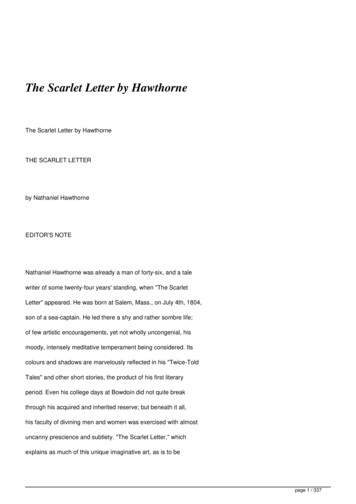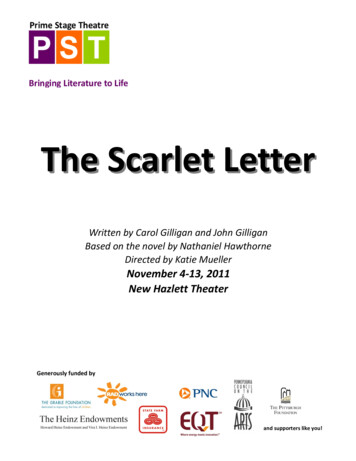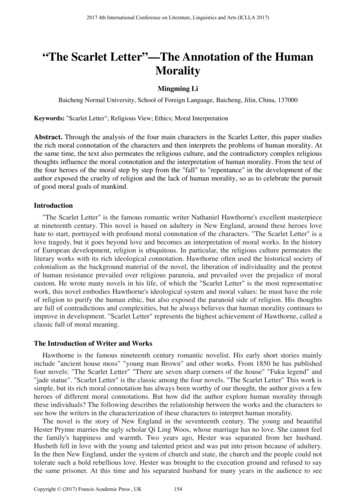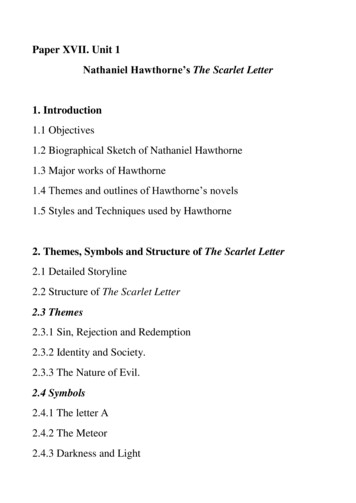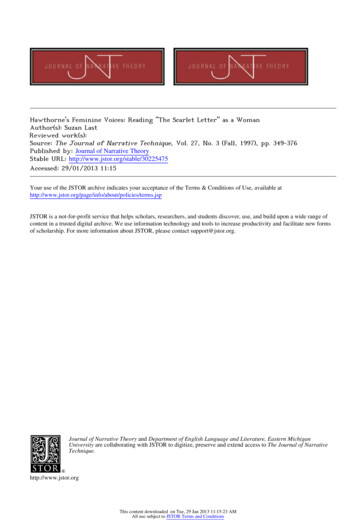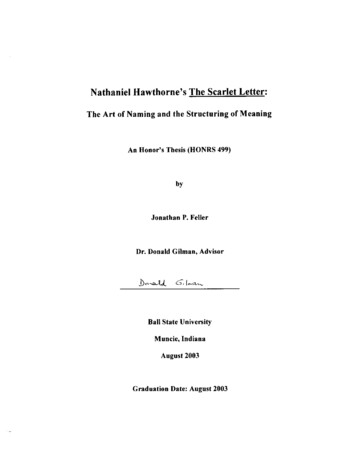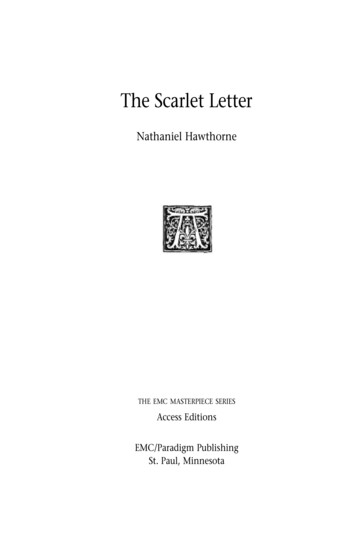
Transcription
The Scarlet LetterNathaniel HawthorneTHE EMC MASTERPIECE SERIESAccess EditionsEMC/Paradigm PublishingSt. Paul, Minnesota
Staff Credits:For EMC/Paradigm Publishing, St. Paul, MinnesotaLaurie SkibaEditorEileen SlaterEditorial ConsultantShannon O’Donnell TaylorAssociate EditorFor Penobscot School Publishing, Inc., Danvers, MassachusettsEditorialDesign and ProductionRobert D. ShepherdPresident, Executive EditorCharles Q. BentProduction ManagerChristina KolbManaging EditorSara DayArt DirectorKim Leahy BeaudetEditorTatiana CicutoCompositorSara HyryEditorMarilyn Murphy ShepherdEditorSharon SalingerCopyeditorISBN 0–8219–1617–3Copyright 1998 by EMC CorporationAll rights reserved. No part of this publication may be adapted, reproduced,stored in a retrieval system or transmitted in any form or by any means, electronic, mechanical, photocopying, recording, or otherwise without permission from the publishers.Published by EMC/Paradigm Publishing875 Montreal WaySt. Paul, Minnesota 55102Printed in the United States of America.10 9 8 7 6 5 4 3 xxx 02 01 00 99 98 97
Table of ContentsThe Life and Works of Nathaniel Hawthorne . . . . . . . . . . ivTime Line of Hawthorne’s Life . . . . . . . . . . . . . . . . . . . . . . viThe Historical Context of The Scarlet Letter . . . . . . . . . . . viiiCharacters in The Scarlet Letter . . . . . . . . . . . . . . . . . . . . . xiiIllustrations . . . . . . . . . . . . . . . . . . . . . . . . . . . . . . . . . . . . xivThe Custom-House, Introductory to “The Scarlet Letter” 1Chapter I, The Prison-Door . . . . . . . . . . . . . . . . . . . . . . . 42Chapter II, The Market-Place. . . . . . . . . . . . . . . . . . . . . . . 44Chapter III, The Recognition. . . . . . . . . . . . . . . . . . . . . . . 56Chapter IV, The Interview . . . . . . . . . . . . . . . . . . . . . . . . . 65Chapter V, Hester at Her Needle . . . . . . . . . . . . . . . . . . . . 74Chapter VI, Pearl . . . . . . . . . . . . . . . . . . . . . . . . . . . . . . . . 83Chapter VII, The Governor’s Hall . . . . . . . . . . . . . . . . . . . 93Chapter VIII, The Elf-Child and the Minister. . . . . . . . . 100Chapter IX, The Leech. . . . . . . . . . . . . . . . . . . . . . . . . . . 111Chapter X, The Leech and His Patient . . . . . . . . . . . . . . 120Chapter XI, The Interior of a Heart . . . . . . . . . . . . . . . . 131Chapter XII, The Minister’s Vigil . . . . . . . . . . . . . . . . . . 138Chapter XIII, Another View of Hester . . . . . . . . . . . . . . 150Chapter XIV, Hester and the Physician . . . . . . . . . . . . . 158Chapter XV, Hester and Pearl . . . . . . . . . . . . . . . . . . . . 166Chapter XVI, A Forest Walk . . . . . . . . . . . . . . . . . . . . . . 172Chapter XVII, The Pastor and His Parishioner . . . . . . . 180Chapter XVIII, A Flood of Sunshine . . . . . . . . . . . . . . . . 189Chapter XIX, The Child at the Brook-Side . . . . . . . . . . . 197Chapter XX, The Minister in a Maze . . . . . . . . . . . . . . 203Chapter XXI, The New England Holiday . . . . . . . . . . . 215Chapter XXII, The Procession . . . . . . . . . . . . . . . . . . . . . 223Chapter XXIII, The Revelation of the Scarlet Letter. . . . 235Chapter XXIV, Conclusion . . . . . . . . . . . . . . . . . . . . . . . 243Plot Analysis of The Scarlet Letter. . . . . . . . . . . . . . . . . . . 250Creative Writing Activities . . . . . . . . . . . . . . . . . . . . . . . 252Critical Writing Activities . . . . . . . . . . . . . . . . . . . . . . . . 254Projects. . . . . . . . . . . . . . . . . . . . . . . . . . . . . . . . . . . . . . . 256Glossary . . . . . . . . . . . . . . . . . . . . . . . . . . . . . . . . . . . . . . 258Handbook of Literary Terms . . . . . . . . . . . . . . . . . . . . . . 267
THE LIFE AND WORKS OFNathaniel HawthorneNathaniel Hawthorne.Peabody Essex MuseumivTHE SCARLET LETTERNathaniel Hawthorne (1804–1864). Born on July 4 in Salem,Massachusetts, Nathaniel was the second child and the onlyson of Elizabeth and Nathaniel Hathorne. By the timeNathaniel was born, five generations of Hathornes had livedin Salem. Two of the most infamous of these ancestors wereWilliam Hathorne and his son, John. William was a Puritanleader and a fierce persecutor of the Quakers. He ordered thata Quaker named Ann Coleman receive a public whipping; shealmost died during this harsh punishment. John was a judgewho conducted hearings during the Salem Witchcraft Trials.As a young man, Nathaniel added a w to his last name. Somespeculate that he made this change to distance himself fromhis intolerant Puritan ancestors.Nathaniel’s father was a seaman who caught yellow feverand died in Surinam (Dutch Guiana) in 1808, whenNathaniel was only four years old. The sea captain left hiswife with little money, so Elizabeth sold the Hathorne houseand moved her family into the home of her more wealthybrothers, the Mannings.When Nathaniel was nine, he injured his leg and wasunable to attend school for almost two years; however, hebegan reading widely on his own. Hawthorne was particularly influenced by the allegory and symbolism in works such asJohn Bunyan’s Pilgrim’s Progress and Edmund Spenser’s TheFaerie Queene, as well as by Sir Walter Scott’s historicalromances and by the works of eighteenth-century novelistssuch as Henry Fielding and Tobias Smollet.In September of 1821, Hawthorne entered Bowdoin College,where he befriended Henry Wadsworth Longfellow, FranklinPierce, and Horatio Bridge. In college, Hawthorne continuedhis extensive reading, enjoyed the Maine outdoors, andexcelled in composition. Hawthorne graduated from Bowdoinin 1825 and returned to Salem. For the next twelve years, hewrote prodigiously, attempting to establish himself as a respected writer. He published his first romance, Fanshawe, at his ownexpense but later tried to retrieve all copies of the book andburn them. Similarly, Hawthorne burned his first collection ofstories, Seven Tales of My Native Land, because he failed to finda publisher. Eventually, in 1830, he published five stories in TheSalem Gazette, and in 1834, some of his stories appeared in New
England Magazine. In 1836, Hawthorne worked as an editor forthe Boston-based The American Magazine of Useful andEntertaining Knowledge. In 1837, he published Twice-Told Tales,a collection of stories that finally brought him recognition.Hawthorne was unaware that his college friend Horatio Bridgehad given the publisher financial guarantees against failure asan incentive to publish this work. The same year, Hawthornemet his future wife, Sophia Amelia Peabody, to whom he wasengaged in 1838. To save money for his marriage, Hawthorneworked as a salt and coal measurer in the Boston CustomHouse, and planning for his future, bought shares in BrookFarm, a utopian Transcendentalist community, intending tolive there with Sophia once they were married. However, communal living did not agree with Hawthorne, and he soonrequested the return of his stock.Hawthorne and Sophia married on July 9, 1842, and movedinto the Old Manse, a house in Concord that they rented fromRalph Waldo Emerson. In Concord, Hawthorne formedfriendships with Transcendentalist writers and thinkers suchas Emerson, Henry David Thoreau, and Bronson Alcott. In1845, the Hawthorne family returned to Salem, and in the following year, Hawthorne published Mosses from an Old Manse,a work that brought critical acclaim but little financial success.Hawthorne’s financial woes were temporarily solved whenPresident James K. Polk made him surveyor of the SalemCustom House. Hawthorne wrote little while working at theCustom House. In 1849, Zachary Taylor, a Whig, became president, and Hawthorne, a Democrat, lost his office. InSeptember, Hawthorne began work on The Scarlet Letter andon “The Custom-House,” which satirizes the Salem CustomHouse and its officers, as well as the Whigs who deprived himof his office. Hawthorne originally planned to include “TheCustom House,” The Scarlet Letter, and other works in a collection called Old Time Legends; Together with Sketches,Experimental and Ideal. By 1850, Hawthorne had published TheScarlet Letter, and he published The House of the Seven Gables by1851. By this time, he, his wife, and their children had movedfrom Lenox, Massachusetts, to West Newton, Massachusetts,where Hawthorne’s second daughter was born. TheHawthorne family returned to Concord in 1852.In 1853, President Franklin Pierce appointed Hawthorneto the post of American consul at Liverpool, England, andHawthorne served in this position for four years before moving his family to Italy for a year. Hawthorne and his familyreturned to Concord in 1860, where he published a collection of English sketches under the title Our Old Home in1863. Nathaniel Hawthorne died in 1864, leaving severalunfinished works.Hawthorne’s friend RalphWaldo Emerson was aleading Transcendentalist.The Transcendentalistsbelieved in spiritual truthsthat lay beyond sense perceptions and materialthings. They also believedthat one could glimpsethese truths through communion with nature.THE LIFE AND WORKS OF NATHANIEL HAWTHORNEv
Time Line of Hawthorne’s LifeviJuly 4, 1804Nathaniel Hathorne is born in Salem, Massachusetts, son of ElizabethClarke Manning Hathorne and Nathaniel Hathorne.1808Nathaniel Hathorne’s father catches yellow fever and dies in Surinam(Dutch Guiana) while working as a sea captain. Elizabeth Hathorne movesNathaniel and his two sisters into the Manning family’s house.April 1813Nathaniel is injured when a ball hits his foot. Unable to attend school foralmost two years after this injury, he begins reading widely on his own.1818Hathorne’s family moves to Raymond, Maine, where Hathorne wanders,hunts, and fishes.1819Hathorne returns to Salem to prepare for college.1821Hathorne enters Bowdoin College in Brunswick, Maine, near Raymond.There he meets Henry Wadsworth Longfellow, Horatio Bridge, and FranklinPierce. Shortly after this time, Hawthorne adds a w to his last name.1825Hawthorne graduates from college and returns to live with his family inSalem.1828Hawthorne publishes Fanshawe, a romance set in a college, at his ownexpense, but later tries to recover and burn all the copies he can find. Afterhe fails to find a publisher, Hawthorne also burns Seven Tales of My NativeLand, a collection of stories that he began to write while in college.1830Hawthorne publishes five stories in The Salem Gazette.1832Hawthorne plans a collection called The Story Teller.1834Some of the stories Hawthorne planned to include in The Story Teller arepublished in New England Magazine.1836Hawthorne moves to Boston to edit a short-lived magazine called TheAmerican Magazine of Useful and Entertaining Knowledge.1837Hawthorne’s Twice-Told Tales is published. Hawthorne meets Sophia AmeliaPeabody, his future wife.1838Hawthorne becomes engaged to Sophia Peabody.1839–1840Hawthorne works as a salt and coal measurer in the Boston Custom Houseto save money for his marriage.1841Hawthorne tries communal living in the experimental Brook Farm community.THE SCARLET LETTER
Hawthorne and Sophia Peabody marry and move to the Old Manse, a housethat they rent from Ralph Waldo Emerson, in Concord, Massachusetts.1842Hawthorne’s first daughter, Una, is born.1844Hawthorne moves to Salem with his wife and daughter.1845Hawthorne’s Mosses from an Old Manse is published and receives criticalacclaim. Hawthorne is appointed surveyor of customs in Salem by PresidentJames K. Polk. Julian, Hawthorne’s first son, is born.1846Hawthorne is removed from office after Zachary Taylor, a Whig, is electedPresident. He begins writing The Scarlet Letter and “The Custom-House.”1849The Scarlet Letter is published. Hawthorne moves to Lenox, Massachusetts,in the Berkshires, where he meets Herman Melville.1850The House of the Seven Gables is published. The Hawthornes move to WestNewton, Massachusetts. Rose, Hawthorne’s second daughter and thirdchild, is born.1851The Blithedale Romance is published. Hawthorne buys a house in Concord,which he names The Wayside. He writes a campaign biography ofPresidential candidate and former classmate Franklin Pierce.1852President Pierce appoints Hawthorne American consul at Liverpool,England. Hawthorne and his family move to England. Hawthorne keepsnotebooks dealing with his experiences abroad.1853Hawthorne gives up his consulship.1857Hawthorne and his family travel to Rome and take up residence there and,later, in Florence. He begins writing a romance based on his observationsin Italy.1858Hawthorne returns to England and continues writing his Italian romance.1859The Marble Fawn is published. Hawthorne returns with his family to TheWayside in Concord.1860Hawthorne’s English sketches are published under the title Our Old Home.1863Hawthorne dies in Plymouth, New Hampshire, while traveling with Pierce.1864TIME LINE OF HAWTHORNE’S LIFEvii
THE HISTORICAL CONTEXT OFThe Scarlet LetterThe Protestant Reformation and PuritanismFor approximately twelve hundred years, the major religion of Europe was Catholicism. In the sixteenth century, aGerman monk named Martin Luther started a movementthat was to overthrow the power of the Catholic Church andsplit Christian Europe into two major groups—the Catholicsand the Protestants. In 1517, Luther nailed to the door of achurch in Wittenburg, Germany, a list of objections to central beliefs and practices of the Catholic Church. Whilepreparing for his ordination as a priest, Luther had beenstruck by his own unworthiness to take the holy sacraments.He believed that because of the original sin of Adam in theGarden of Eden, people were basically sinful and could not,through their works, become worthy of taking such sacraments as Holy Communion and Holy Orders. Instead, according to Luther, people had to depend on the grace of God,extended to them despite their sinfulness. Luther also objected to practices of the church such as the sale of indulgences,or pardons for sins. He challenged the authority of the Popeand of the church in general, claiming that religion was a matter of individual conscience to be worked out between eachperson and God without a priest as intermediary. This beliefled him to emphasize reading of the Holy Scriptures, whichwas made possible for ordinary men and women by the invention of printing and the translation of the Bible from Latinand Greek into everyday European languages.Luther’s ideas spread throughout Europe, leading to awidespread, often bloody revolt against Catholic authorityknown as the Protestant Reformation. In England, KingHenry VIII broke with Catholicism and formed the Churchof England, or Anglican Church, a Protestant denominationwith himself at its head, because the Catholic Church wouldnot allow him to divorce.viiiTHE SCARLET LETTER
A central figure in the Protestant Reformation was JohnCalvin of Switzerland, who took Luther’s ideas about original sin a step further, teaching that all events are preordained by God, that God chose at the beginning of timewhich people (the elect) would be saved, and which wouldbe damned. This Calvinist doctrine, known as predestination, became the central belief of the Puritan Movementthat was to flourish in England and in the English colonies.Puritanism in New EnglandSome Protestants in England did not accept the AnglicanChurch but wished to “purify” it by simplifying services andby enforcing stricter moral codes. Facing persecution inEngland, some of these Puritans, as their opponents calledthem, fled to America, where they hoped to establish coloniesbased on religious principles. The Plymouth Colony, foundedin 1620, and the Massachusetts Bay Colony, founded in1630, were Puritan settlements, both in New England. TheNew England colonists endured great difficulties and depended on the assistance of Native Americans to survive. Thecore group of the Plymouth colonists, often referred to as thePilgrims, were Separatist Puritans, so called because they hadofficially separated from the Anglican Church due to its“Popish,” or Catholic, tendencies. After moving fromEngland to Holland to escape religious persecution, thePilgrims set sail for North America on the Mayflower in 1620.They landed on Cape Cod and established their colony bymeans of the Mayflower Compact in what is now the town ofPlymouth, Massachusetts. After a difficult winter, thecolonists learned from native peoples how to plant crops thatwould grow in the harsh climate. Under the direction of governor William Bradford, the colony flourished.In 1691, Plymouth incorporated with a much larger settlement of Puritans, the Massachusetts Bay Colony. This groupwas made up of Congregationalist Puritans who did not separate entirely from the Anglican Church, believing it could bereformed from within. They found courage to face the hardships of their new lives in America by believing that theiractions were divinely guided. Their governor, John Winthrop,would write in his work, A Model of Christian Charity, thatthey were in the business of building, as described in the NewTestament, a “city upon a hill” in the new land. Hawthorne’sThe Scarlet Letter is set in the Massachusetts Bay Colony inthe early 1640s.THE HISTORICAL CONTEXT OF THE SCARLET LETTERix
Puritan BeliefsThe Puritans in New England shared several basic religiousand social beliefs. First, they believed strongly in the importance of the community as a whole. The idea that they wereon a grand historical and religious mission gave them a common purpose. The societies that they created were theocracies, ruled by strict religious principles. Second, because theyhad a firm belief in original sin, they accepted the idea thatpeople were basically wicked and could only be savedthrough grace. This belief in the wickedness of people led thePuritans to enact strict laws and punishments. Third,although the Puritans as a whole believed themselves to bechosen by God for a special mission, they did not believethat all the people among them had been chosen. Theyadopted John Calvin’s theory of predestination, which heldthat God had chosen some people to be saved and some tobe damned. They understood this to mean that they couldnot change their individual fates directly, by force of will.Since none could be sure of having been saved, however,they maintained a steady and humble watch over theirlives for proof that they were among the elect, those chosen for salvation by God at the beginning of time. Finally,the Puritans shared a belief in hard work, thinking thatmaterial and social success were signs of God’s providenceand that such work, though it could not win salvation, wasnonetheless a sign of salvation. This complex belief in strictmoral propriety and hard work is today referred to as thePuritan ethic.Politics, Society, and OrthodoxyDespite the shared beliefs of the Puritans, their society wasnot entirely free of conflict, or dissent. Early Puritan leaderswere largely intolerant of any opposition, religious or political. When Roger Williams voiced his objections in 1635 tointolerance of diversity and mistreatment of NativeAmericans, he was banished from the Massachusetts BayColony. He went on to found the colony of Rhode Islandand to call for religious freedom. In 1637, when AnneHutchinson bypassed the official church and began teaching her own theories in home Bible classes with otherwomen and their husbands, she was accused of threateningthe established religion and of being more a “husband thana wife.” She was banished from the Massachusetts BayColony as well. Other dissenters did not fare so well. Puritanpunishments could be extremely harsh and included publicxTHE SCARLET LETTER
ridicule, placement in stockades, imprisonment, flogging,drowning, hanging, and being crushed under stones.Pressures from progressive elements in New England ledin 1662 to the Half-Way Covenant, a new law that relaxedold rules and allowed more people direct membership in thechurch. However, tensions remained. Some saw the relaxingof orthodoxy as a sign of weakness, and their concerns surfaced dramatically in the belief that Satan had infiltrated thetown of Salem and nearby communities. The Salem WitchTrials, begun in 1692, resulted in the execution of twentypeople and the imprisonment and torture of many more.Nathaniel Hawthorne was keenly aware of and embarrassedby his own ancestor’s participation in these trials.Hawthorne was able to express his concern in his greatnovel, The Scarlet Letter, which deals with issues of sin, punishment, and redemption.THE HISTORICAL CONTEXT OF THE SCARLET LETTERxi
Characters in The Scarlet LetterMain CharactersHester Prynne. Hester is an English woman who is sent tolive in the American colonies by her husband, Roger Prynne,an aged scholar. Prynne plans to join her after he settles business matters in Amsterdam, where the couple has been living. When the novel begins, Hester has been living in Bostonfor two years without her husband, who has never arrived.Hester has given birth to a child by a father unknown to thecommunity and has been found guilty of the sin of adultery.As punishment, she must always wear a scarlet A on her dressand stand for three hours on a public scaffold, exposed to theridicule and rancor of the community.Reverend Arthur Dimmesdale. Arthur Dimmesdale, an unmarried man, is the pastor of Hester’s congregation and the father ofHester’s baby, Pearl. Hester refuses to name him as the father ofthe child, but Dimmesdale’s private guilt and anguish eat awayat him throughout the novel.Pearl. Pearl is the daughter of Hester Prynne and the ReverendArthur Dimmesdale. She is the living symbol of Hester’s sin andgrows up fascinated by her mother’s scarlet A. Pearl has a strong,unpredictable personality, and Hester worries that Pearl will betaken from her.Roger Chillingworth. Roger Chillingworth is the name Hester’shusband assumes after he finally arrives in America. NativeAmericans have captured him, delaying his arrival in thecolony. At the beginning of the novel, Hester recognizes herhusband from her place on the public scaffold. Later, he asks hernot to dishonor his name by revealing that he is her lawful husband. Chillingworth becomes obsessed with seeking revengeagainst Dimmesdale.xiiTHE SCARLET LETTER
Minor CharactersGovernor Richard Bellingham. This character, an actualhistorical figure who served as governor in Boston in 1641,1654, and 1665, witnesses Hester’s punishment on the public scaffold. Later in the novel, Hester must visit him to askthat Pearl not be removed from her home.Mistress Hibbins. This character, another actual historicalfigure, is the sister of Governor Bellingham and is supposedlyin league with the devil. She tries to tempt Hester andDimmesdale to sink further into sin. The real Mistress Hibbinswas executed for witchcraft.John Wilson. This character advises Dimmesdale to try tofind out from Hester who the father of her child is. WhenHester refuses to reveal this information, Wilson delivers asermon about adultery to the crowd watching Hester onthe scaffold.Master Brackett. Master Brackett is the jailer who bringsChillingworth to Hester as she sits in prison.The Sexton. Dimmesdale stands on the public scaffold withHester and Pearl one night, and the sexton, an employee ofthe church, finds Reverend Dimmesdale’s glove there andreturns it to him. The sexton asks Dimmesdale about the redletter A that appeared in the sky that night. The sextonbelieves that the A stands for “angel.” Dimmesdale denieshaving seen the sign in the sky.The Shipmaster. This character is the captain of the ship onwhich Hester, Pearl, and Dimmesdale hope to leave Boston.The shipmaster tells them that Roger Chillingworth alsoplans to be on the ship.CHARACTERS IN THE SCARLET LETTERxiii
The woman and herdaughter pictured tothe right are wearinglong dresses andcaps, typical Puritangarb such as Hesterand Pearl might haveworn. The basketcarried by thewoman might holdfood she has gathered from the forestor her garden, a parcel from a shop, hersewing, or some foodfor a sick neighbor.xivTHE SCARLET LETTER
The man pictured tothe left is wearing anoutfit that wouldhave been commonto colonialPuritans—kneebreeches, coat, cape,and hat.ILLUSTRATIONSxv
WESTHILL BEACONPRISON WILLIAM HIBBON xviTHE SCARLET LETTER
MILLFIELD REVEREND WILSONNFORTHILLBOSTON CIRCA 1645ILLUSTRATIONSxvii
1. footnote. This is a footnote.2. footnote. This is another footnote.3. footnote. This is another footnote.WWordsForEverydayUseinvariably (phonetic here) adj., meaning hereponderous (phonetic here) adj., meaning herepertain (phonetic here) v., meaning hereTHE CUSTOM HOUSExix
THE CUSTOM-HOUSEIntroductory to “The Scarlet Letter”It is a little remarkable, that—though disinclined to talkovermuch of myself and my affairs at the fireside, and to mypersonal friends—an autobiographical impulse should twicein my life have taken possession of me, in addressing the public. The first time was three or four years since, when I favoredthe reader—inexcusably, and for no earthly reason, thateither the indulgent reader or the intrusive author couldimagine—with a description of my way of life in the deepquietude of an Old Manse. And now—because, beyond mydeserts, I was happy enough to find a listener or two on theformer occasion—I again seize the public by the button, andtalk of my three years’ experience in a Custom-House. Theexample of the famous “P. P., Clerk of this Parish,”1 was nevermore faithfully followed. The truth seems to be, however,that, when he casts his leaves forth upon the wind, theauthor addresses, not the many who will fling aside his volume, or never take it up, but the few who will understandhim, better than most of his schoolmates and lifemates. Someauthors, indeed, do far more than this, and indulge themselves in such confidential depths of revelation as could fittingly be addressed, only and exclusively, to the one heartand mind of perfect sympathy; as if the printed book, thrownat large on the wide world, were certain to find out the divided segment of the writer’s own nature, and complete his circle of existence by bringing him into communion with it. Itis scarcely decorous, however, to speak all, even where wespeak impersonally. But—as thoughts are frozen and utterance benumbed, unless the speaker stand in some true relation with his audience—it may be pardonable to imagine thata friend, a kind and apprehensive,2 though not the closestfriend, is listening to our talk; and then, a native reserve being Who is speaking?What impulse hastaken possession ofthis person?1. “P. P., Clerk of this Parish.” Hawthorne is referring to a satirical biographyhe had read.2. apprehensive. Quick to understandWWordsForEverydayUsedis in clined (dis in kl nd ) adj., unwilling, reluctantTHE CUSTOM-HOUSE1
According to thenarrator, what willthe custom housesketch explain?thawed by this genial consciousness, we may prate of the circumstances that lie around us, and even of ourself, but stillkeep the inmost Me behind its veil. To this extent and withinthese limits an author, methinks, may be autobiographical,without violating either the reader’s rights or his own.It will be seen, likewise, that this Custom-House sketch hasa certain propriety, of a kind always recognized in literature,as explaining how a large portion of the following pagescame into my possession, and as offering proofs of theauthenticity of a narrative therein contained. This, in fact—a desire to put myself in my true position as editor, or verylittle more, of the most prolix among the tales that make upmy volume3—this, and no other, is my true reason forassuming a personal relation with the public. In accomplishing the main purpose, it has appeared allowable, by a fewextra touches, to give a faint representation of a mode of lifenot heretofore described, together with some of the characters that move in it, among whom the author happened tomake one.In my native town of Salem, at the head of what, half acentury ago, in the days of old King Derby,4 was a bustlingwharf—but which is now burdened with decayed woodenwarehouses, and exhibits few or no symptoms of commerciallife; except, perhaps, a bark or brig,5 half-way down itsmelancholy length, discharging hides; or, nearer at hand, aNova Scotia schooner, pitching out her cargo of firewood—at the head, I say, of this dilapidated wharf, which the tideoften overflows, and along which, at the base and in the rearof the row of buildings, the track of many languid years isseen in a border of unthrifty grass—here, with a view fromits front windows adown this not very enlivening prospect,and thence across the harbor, stands a spacious edifice ofbrick. From the loftiest point of its roof, during preciselythree and a half hours of each forenoon, floats or droops, inbreeze or calm, the banner of the republic; but with the thirteen stripes turned vertically, instead of horizontally, andthus indicating that a civil, and not a military post of Uncle3.The4.5.my volume. Hawthorne originally planned to publish “The Custom-House,”Scarlet Letter, and several other sketches and tales in one volume.King Derby. Elias Hasket Derby (1739–1799), a merchant and ship ownerbark or brig. Types of boatsWWordsForEverydayUse2THE SCARLET LETTERgen i al (jēn yəl) adj., friendly and sympatheticdi lap i dat ed (də lap ə dāt id) adj., shabby, neglected, and broken downlan guid (laŋ wid) adj., indifferent; dull
Sam’s government, is here established. Its front is ornamentedwith a portico6 of half a dozen wooden pillars, supporting abalcony, beneath which a flight of wide granite steps descendstowards the street. Over the entrance hovers an enormousspecimen of the American eagle, with outspread wings, ashield before her breast, and, if I recollect aright, a bunch ofintermingled thunderbolts and barbed arrows in each claw.With the customary infirmity of temper that characterizes thisunhappy fowl, she appears, by the fierceness of her beak andeye and
September, Hawthorne began work on The Scarlet Letter and on "The Custom-House," which satirizes the Salem Custom-House and its officers, as well as the Whigs who deprived him of his office. Hawthorne originally planned to include "The Custom House," The Scarlet Letter, and other works in a collec-


